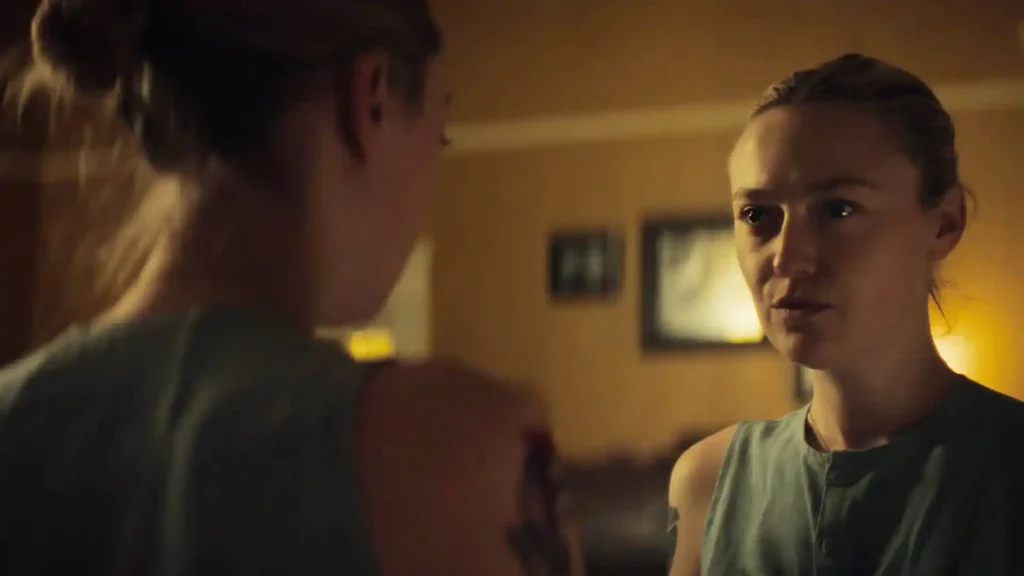
WARNING: THIS ARTICLE CONTAINS MAJOR SPOILERS
Vicious doesn’t have the kind of ending you can explain. Everyone who watches it will likely take something different from it and have a different theory about why a mysterious box is tormenting Dakota Fanning and her neighbours. The final scenes are deliberately confounding, throwing in new ideas and details that upend previous assumptions. Let’s be frank, I can’t make any of this make sense for you.
But this is precisely the kind of movie it’s fun to mull over and think about. That’s what this is. It isn’t an explanation or a recounting of the plot – it’s riffing, really, me trying to work through all the different ideas and theories bobbing around in my head. Maybe you’ll agree, maybe you won’t, but that’s all part of the fun. Well, as fun as a movie about a woman cutting her fingers and toes off can be, obviously.

The Box Targets Broken People
Initially, it seems like Polly ending up with the magic death box is an entirely random event. Kathryn Hunter’s character – whose name I didn’t catch, sorry – turns up and gives it to her seemingly at random, and Polly later offloads it, again seemingly at random. This would be in keeping with a theme Bryan Bertino likes, since it also underpinned The Strangers in that infamous scene where the masked killers justify their murder spree with a shrugging, “You were home.”
But not so fast! Hunter’s character says outright that the box targets broken people; she could have given it to anyone, but she ended up giving it to someone who had a lot of personal issues to work through. Based on the very final scenes, Polly also seems to have done the same, without even realising. This lends credence to the idea that the box is choosing who it ends up with, and more importantly, tailoring its requirements to unpick their specific issues and anxieties.
Polly’s experiences with the box forced her to consider what was important in her life, a life she had written off as being aimless and unfulfilled. It allowed her to work through her complicated feelings about religion following the death of her father. It reaffirmed her love for her sister and her niece. These were the specific issues she was grappling with internally. The box just made them manifest.
The Secret Is Not To Play
Polly’s ultimate way out of the box’s thrall is refusing to play the game. It’s only by letting the sands run empty, letting the timer expire, that the game ends. Could she have done that at the start and avoided having to lop her own forefinger and pinky toe off? Probably. But the box knew she wouldn’t. She was too afraid of the people she loved being harmed.
Everything the box presents to Polly, everything it makes her do, seems designed to keep her playing. In the final scenes, when it’s revealed that Polly’s neighbour is trapped in her own game, we see that the walls are daubed with a warning not to trust Polly. The box can’t let on that she has figured it out.
And it does seem like Polly has figured it out. Seeing her other neighbor, the one who stabbed herself in the face and neck, being alive and well suggests she has freed herself from its influence. It’s the same with her sister and niece, who were dead in her visions. Her own finger and toe are still missing, though, proving the experiences were real. It seems like anyone who is directly in possession of the box has to live with its consequences, but anyone who was harmed to torment them doesn’t suffer. Polly’s acceptance of what she believes to be death, letting the timer run through, and her later refusal to look at her phone when it rings, reiterates that she is now resistant to its powers – no longer afraid.
The Game Is Different For Everyone
The box demands that Polly feed it three things: Something she loves, something she hates, and something she needs. These are obviously open to interpretation, but they’re also generic enough that you’d think they’re the same demands the box makes of everyone. But the closing scene disproves this. We see Polly’s neighbor put something into the box and say, “Something you want.” For her, the requirements were different, though the outcomes have been similarly brutal. She’s also missing fingers, and her parents are dead in the room behind her.
There’s no indication of what the box demanded of Kathryn Hunter’s character, except that she, too, is missing fingers, and when she turns up later, she’s also missing an eye. But there’s a unique element to her point of view, which is that when Polly remembers their initial meeting, when she’s looking in the mirror, past-Kathryn Hunter clearly meets her eye. She can see her in the future, all bloody, traumatised, and separated from her digits. This is when she says, “You’re going to die.” It’s not a soothsayer’s random prognostication. She’s telling her what she’s seeing in the mirror.
This kind of connectivity isn’t expressed elsewhere, but it’s interesting to think about how each “player” experienced a slightly different – but no less damaging – version of the same “game”. Ultimately, there are no concrete answers to be had here, which is the point, but it has definitely been fun to ponder. Let me know any of your own theories in the comments.


